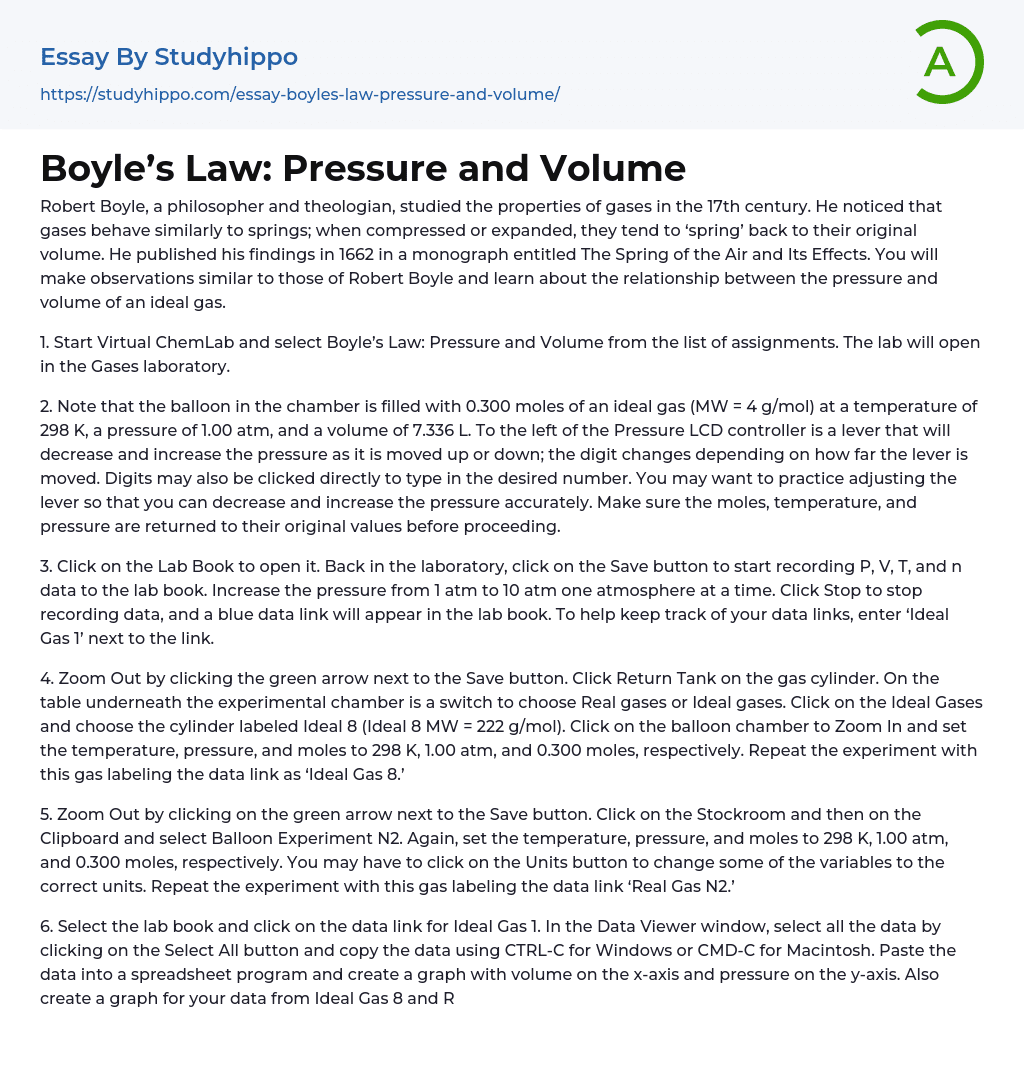Robert Boyle, a philosopher and theologian, studied the properties of gases in the 17th century. He noticed that gases behave similarly to springs; when compressed or expanded, they tend to ‘spring’ back to their original volume. He published his findings in 1662 in a monograph entitled The Spring of the Air and Its Effects. You will make observations similar to those of Robert Boyle and learn about the relationship between the pressure and volume of an ideal gas.
1. Start Virtual ChemLab and select Boyle’s Law: Pressure and Volume from the list of assignments. The lab will open in the Gases laboratory.
2. Note that the balloon in the chamber is filled with 0.300 moles of an ideal gas (MW = 4
...g/mol) at a temperature of 298 K, a pressure of 1.00 atm, and a volume of 7.336 L. To the left of the Pressure LCD controller is a lever that will decrease and increase the pressure as it is moved up or down; the digit changes depending on how far the lever is moved. Digits may also be clicked directly to type in the desired number. You may want to practice adjusting the lever so that you can decrease and increase the pressure accurately. Make sure the moles, temperature, and pressure are returned to their original values before proceeding.
3. Click on the Lab Book to open it. Back in the laboratory, click on the Save button to start recording P, V, T, and n data to the lab book. Increase the pressure from 1 atm to 10 atm one atmosphere at a time. Click Stop to sto
recording data, and a blue data link will appear in the lab book. To help keep track of your data links, enter ‘Ideal Gas 1’ next to the link.
4. Zoom Out by clicking the green arrow next to the Save button. Click Return Tank on the gas cylinder. On the table underneath the experimental chamber is a switch to choose Real gases or Ideal gases. Click on the Ideal Gases and choose the cylinder labeled Ideal 8 (Ideal 8 MW = 222 g/mol). Click on the balloon chamber to Zoom In and set the temperature, pressure, and moles to 298 K, 1.00 atm, and 0.300 moles, respectively. Repeat the experiment with this gas labeling the data link as ‘Ideal Gas 8.’
5. Zoom Out by clicking on the green arrow next to the Save button. Click on the Stockroom and then on the Clipboard and select Balloon Experiment N2. Again, set the temperature, pressure, and moles to 298 K, 1.00 atm, and 0.300 moles, respectively. You may have to click on the Units button to change some of the variables to the correct units. Repeat the experiment with this gas labeling the data link ‘Real Gas N2.’
6. Select the lab book and click on the data link for Ideal Gas 1. In the Data Viewer window, select all the data by clicking on the Select All button and copy the data using CTRL-C for Windows or CMD-C for Macintosh. Paste the data into a spreadsheet program and create a graph with volume on the x-axis and pressure on the y-axis. Also create a graph for your data from Ideal Gas
8 and Real Gas N2.
7. Based on your data, what relationship exists between the pressure and the volume of a gas (assuming a constant temperature)? The pressure varies with the volume, as the pressure increases the volume decreases.
- Organic Chemistry essays
- Acid essays
- Calcium essays
- Chemical Bond essays
- Chemical Reaction essays
- Chromatography essays
- Ethanol essays
- Hydrogen essays
- Periodic Table essays
- Titration essays
- Chemical reactions essays
- Osmosis essays
- Carbohydrate essays
- Carbon essays
- Ph essays
- Diffusion essays
- Copper essays
- Salt essays
- Concentration essays
- Sodium essays
- Distillation essays
- Amylase essays
- Magnesium essays
- Acid Rain essays
- Energy essays
- Density essays
- Thermodynamics essays
- Motion essays
- Atom essays
- Sound essays
- Electricity essays
- Nuclear Power essays
- Temperature essays
- Physiology essays
- Light essays
- Force essays
- Heat essays
- Speed essays
- Big Bang Theory essays
- Energy Development essays
- The elements essays
- Voltage essays
- Solar Energy essays
- Nuclear Energy essays
- Alternative Energy essays
- Melting essays
- Nuclear Family essays
- Atmosphere essays
- Biodiversity essays
- Coral Reef essays




